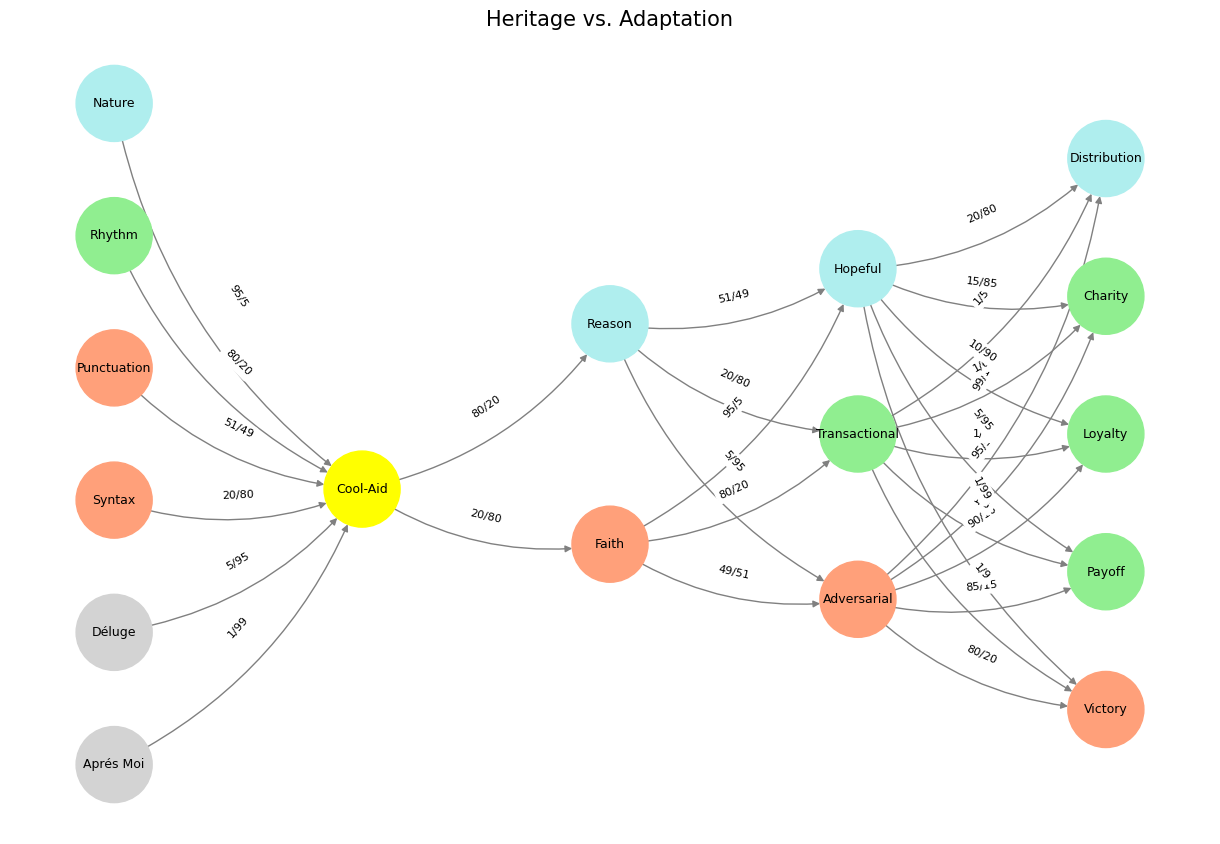Born to Etiquette#
Individuation necessitates deviation, but it doesn’t require a complete uprooting. The most profound transformations still retain a tether to the origin, like a tree growing outward from its roots. Even as one devient (becomes), certain structures—be they cultural, biological, or philosophical—anchor the process.

Fig. 29 I got my hands on every recording by Hendrix, Joni Mitchell, CSN, etc (foundations). Thou shalt inherit the kingdom (yellow node). And so why would Bankman-Fried’s FTX go about rescuing other artists failing to keep up with the Hendrixes? Why worry about the fate of the music industry if some unknown joe somewhere in their parents basement may encounter an unknown-unknown that blows them out? Indeed, why did he take on such responsibility? - Great question by interviewer. The tonal inflections and overuse of ecosystem (a node in our layer 1) as well as clichêd variant of one of our output layers nodes (unknown) tells us something: our neural network digests everything and is coherenet. It’s based on our neural anatomy!#
The key distinction may lie in which aspects remain rooted and which must be abandoned. Nietzsche’s Übermensch, for instance, doesn’t reject all past values wholesale; rather, he selectively reweights them, forging new pathways while maintaining a fundamental connection to human vitality. Marx, too, saw history as a dialectical process—change (deviation) occurring not in isolation but in response to the structures it emerges from.
So individuation isn’t mere rebellion; it’s a negotiation. One must deviate from the collective script to become an autonomous self, but without losing the foundational grammar that allows meaning to emerge. What aspects do you think remain rooted in your own process of becoming?
Show code cell source
import numpy as np
import matplotlib.pyplot as plt
import networkx as nx
# Define the neural network layers
def define_layers():
return {
'Suis': ['Aprés Moi', 'Déluge', 'Syntax', 'Punctuation', "Rhythm", 'Nature'], # Static
'Voir': ['Cool-Aid'],
'Choisis': ['Faith', 'Reason'],
'Deviens': ['Adversarial', 'Transactional', 'Hopeful'],
"M'èléve": ['Victory', 'Payoff', 'Loyalty', 'Charity', 'Distribution']
}
# Assign colors to nodes
def assign_colors():
color_map = {
'yellow': ['Cool-Aid'],
'paleturquoise': ['Nature', 'Reason', 'Hopeful', 'Distribution'],
'lightgreen': ["Rhythm", 'Transactional', 'Payoff', 'Charity', 'Loyalty'],
'lightsalmon': ['Syntax', 'Punctuation', 'Faith', 'Adversarial', 'Victory'],
}
return {node: color for color, nodes in color_map.items() for node in nodes}
# Define edge weights (hardcoded for editing)
def define_edges():
return {
('Aprés Moi', 'Cool-Aid'): '1/99',
('Déluge', 'Cool-Aid'): '5/95',
('Syntax', 'Cool-Aid'): '20/80',
('Punctuation', 'Cool-Aid'): '51/49',
("Rhythm", 'Cool-Aid'): '80/20',
('Nature', 'Cool-Aid'): '95/5',
('Cool-Aid', 'Faith'): '20/80',
('Cool-Aid', 'Reason'): '80/20',
('Faith', 'Adversarial'): '49/51',
('Faith', 'Transactional'): '80/20',
('Faith', 'Hopeful'): '95/5',
('Reason', 'Adversarial'): '5/95',
('Reason', 'Transactional'): '20/80',
('Reason', 'Hopeful'): '51/49',
('Adversarial', 'Victory'): '80/20',
('Adversarial', 'Payoff'): '85/15',
('Adversarial', 'Loyalty'): '90/10',
('Adversarial', 'Charity'): '95/5',
('Adversarial', 'Distribution'): '99/1',
('Transactional', 'Victory'): '1/9',
('Transactional', 'Payoff'): '1/8',
('Transactional', 'Loyalty'): '1/7',
('Transactional', 'Charity'): '1/6',
('Transactional', 'Distribution'): '1/5',
('Hopeful', 'Victory'): '1/99',
('Hopeful', 'Payoff'): '5/95',
('Hopeful', 'Loyalty'): '10/90',
('Hopeful', 'Charity'): '15/85',
('Hopeful', 'Distribution'): '20/80'
}
# Calculate positions for nodes
def calculate_positions(layer, x_offset):
y_positions = np.linspace(-len(layer) / 2, len(layer) / 2, len(layer))
return [(x_offset, y) for y in y_positions]
# Create and visualize the neural network graph
def visualize_nn():
layers = define_layers()
colors = assign_colors()
edges = define_edges()
G = nx.DiGraph()
pos = {}
node_colors = []
# Add nodes and assign positions
for i, (layer_name, nodes) in enumerate(layers.items()):
positions = calculate_positions(nodes, x_offset=i * 2)
for node, position in zip(nodes, positions):
G.add_node(node, layer=layer_name)
pos[node] = position
node_colors.append(colors.get(node, 'lightgray'))
# Add edges with weights
for (source, target), weight in edges.items():
if source in G.nodes and target in G.nodes:
G.add_edge(source, target, weight=weight)
# Draw the graph
plt.figure(figsize=(12, 8))
edges_labels = {(u, v): d["weight"] for u, v, d in G.edges(data=True)}
nx.draw(
G, pos, with_labels=True, node_color=node_colors, edge_color='gray',
node_size=3000, font_size=9, connectionstyle="arc3,rad=0.2"
)
nx.draw_networkx_edge_labels(G, pos, edge_labels=edges_labels, font_size=8)
plt.title("Heritage vs. Adaptation", fontsize=15)
plt.show()
# Run the visualization
visualize_nn()


Fig. 30 Glenn Gould and Leonard Bernstein famously disagreed over the tempo and interpretation of Brahms’ First Piano Concerto during a 1962 New York Philharmonic concert, where Bernstein, conducting, publicly distanced himself from Gould’s significantly slower-paced interpretation before the performance began, expressing his disagreement with the unconventional approach while still allowing Gould to perform it as planned; this event is considered one of the most controversial moments in classical music history.#

